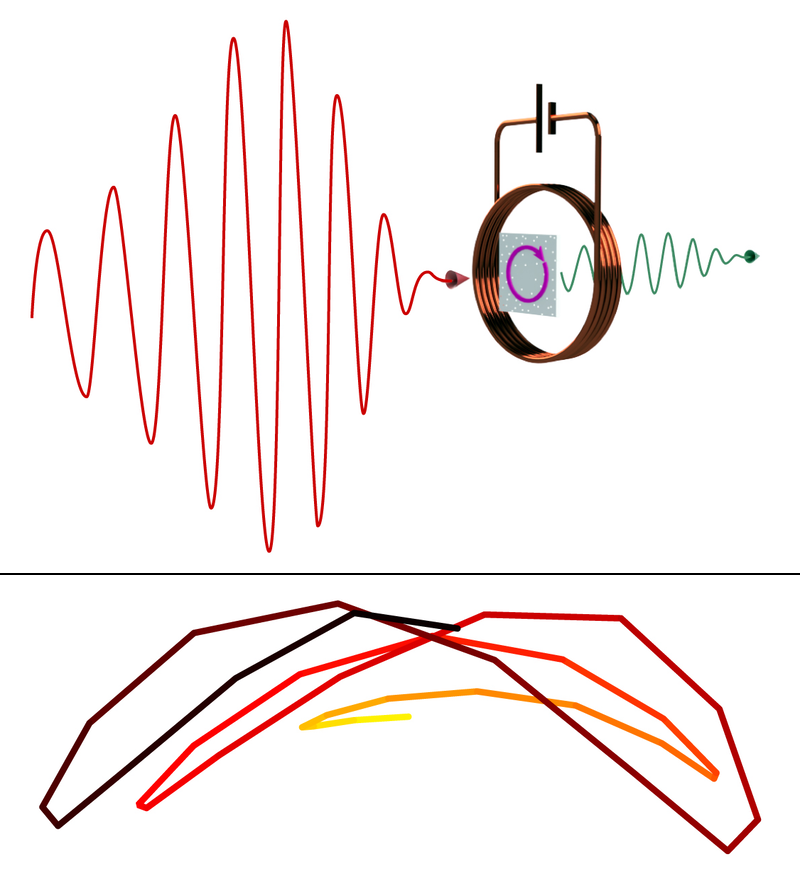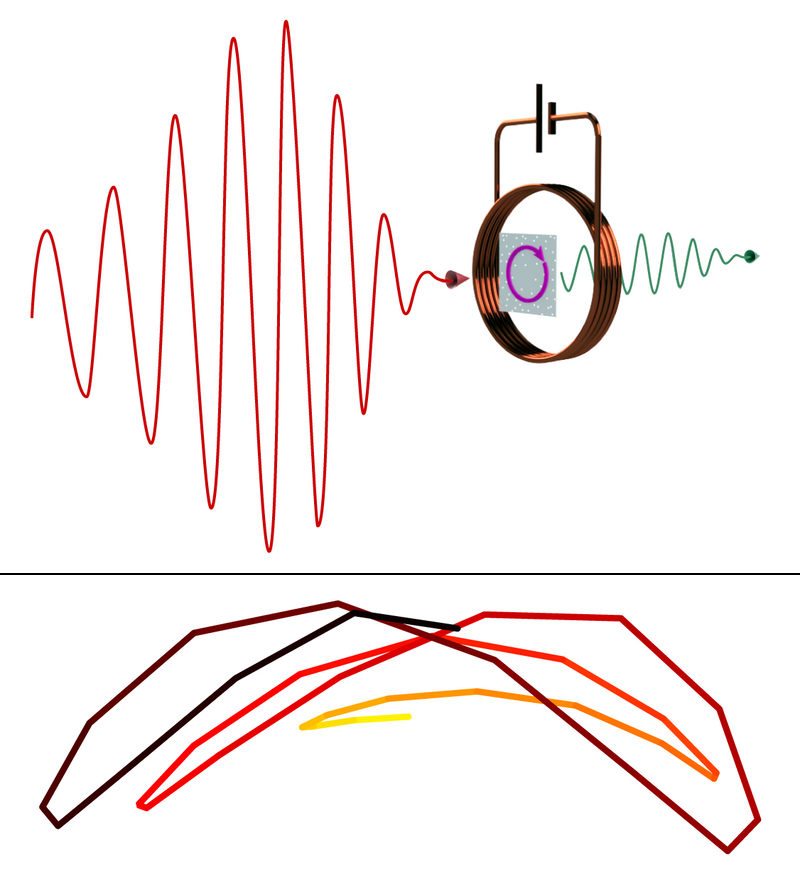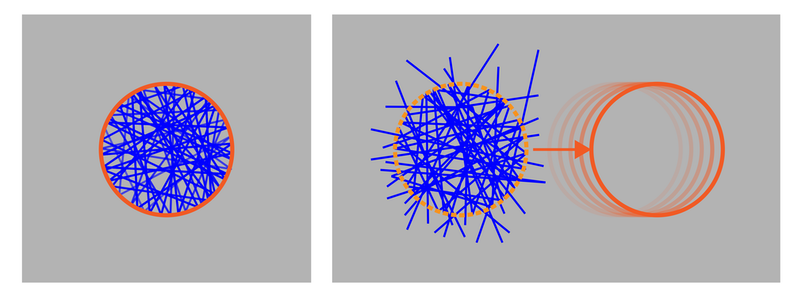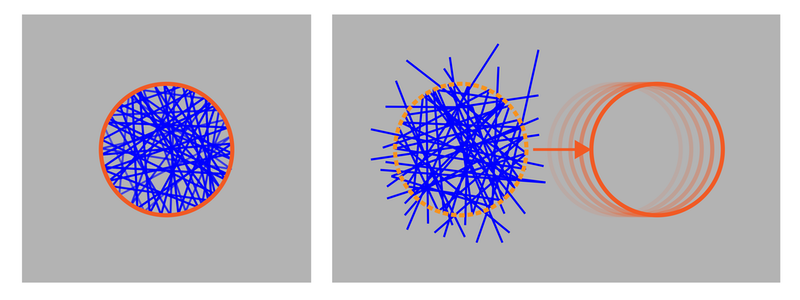Viewing Fast Vortex Motion in a Superconductor
In many superconductors, applying a sufficiently strong magnetic field causes superconducting electrons to create current vortices that can be drawn along with a steady electric current. To learn more about how these vortices move, researchers have now visualized their trajectories in a situation where they are driven to oscillate at near-terahertz frequencies [1]. They observed the vortex motion on picosecond timescales and found that, under these conditions, a vortex’s effective mass is 10,000 times less than expected. This result may be important for efforts to improve high-current superconducting devices.
Superconductors can only deliver current up to a certain maximum value before the superconductivity is destroyed, which is an important concern for the development of high-current devices. Many researchers consider vortices—which can form even in the absence of an external magnetic field—to be the source of this so-called current-induced quenching. But determining how vortices cause quenching requires better knowledge of vortices and thus better measurements of their motion.
Several years ago, Sachiko Nakamura of the University of Tokyo and her colleagues developed a technique that detected vortex motion in the common superconductor niobium nitride [2]. In this technique, current is injected into a thin superconducting film to generate vortices, and the film is then irradiated with an infrared pulse. The pulse emerging from the far side of the film is analyzed, and in Nakamura’s experiments it was found to include a component having double the frequency (the second harmonic) of the input. The team attributed the presence of the second harmonic to one-dimensional vortex oscillation.
Nakamura and her colleagues have now developed their technique to measure vortex motion in two dimensions, this time in the iron-based superconductor FeSe0.5Te0.5, or FST. The researchers fabricated a 38-nm-thick film of FST and cooled it below its superconducting transition temperature (16.5 K). A coil generated a magnetic field, which produced vortices in the film. Additionally, the magnetic field induced a shielding current, which traced out a several-millimeter-diameter circle on the film.
The researchers irradiated the film with a 20-picosecond infrared (0.3-terahertz) pulse and detected a second harmonic in the spectrum of the pulse that emerged from the sample, as in the previous experiments. But here they detected both polarizations of the emitted light, parallel and perpendicular to the incident pulse’s polarization.
Using a roughly 1-mm-wide beam, they probed a region near the ring of the field-induced shielding current and then analyzed the transmitted waveforms in order to reconstruct the motion of a typical vortex residing in that location. The team found an oscillating, roughly parabolic trajectory rather than a straight line. This shape resulted from the interaction between the vortex, which is magnetic, and the shielding current. Discovering this motion was the most exciting part of the work, Nakamura says. “It felt like we were looking directly into the 2D motion of the vortex.”
The data suggest that the vortices moved at speeds as high as 300 km/s, much faster than was predicted. Itsuhiro Kakeya, who studies terahertz technology at Kyoto University, Japan, says that the effective vortex mass, measured from its inertia, was far from expectations. “The mass of a vortex has been thought to be equivalent to 10,000 free electrons, but these results show that it is of the same order as a [single] free electron, which is a surprising claim,” he says. The finding supports a picture in which a rapidly oscillating vortex leaves behind many of the nonsuperconducting electrons originally trapped inside it. Nakamura points out that this scenario implies that vortex theories should treat vortex motion independently from that of the associated nonsuperconducting electrons.
According to Kakeya, visualizing the motion of superconducting vortices on the picosecond timescale is a very important achievement. Zhe Wang, who studies correlated quantum materials at the Technical University of Dortmund, Germany agrees. “Terahertz second-harmonic generation is not very often reported in the literature,” he says. The new study not only reports this phenomenon in a new class of superconductor but also uses it to examine vortex dynamics and properties. “Since other experimental methods have observed unique properties of this material, we expect that their relationship to this small vortex mass will be elucidated,” says Kakeya.
–Rachel Berkowitz
Rachel Berkowitz is a Corresponding Editor for Physics Magazine based in Vancouver, Canada.
References
- S. Nakamura et al., “Picosecond trajectory of two-dimensional vortex motion in FeSe0.5Te0.5 visualized by terahertz second harmonic generation,” Phys. Rev. Lett. 133, 036004 (2024).
- S. Nakamura et al., “Nonreciprocal terahertz second-harmonic generation in superconducting NbN under supercurrent injection,” Phys. Rev. Lett. 125, 097004 (2020).









